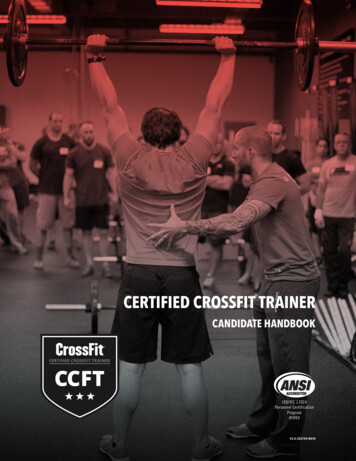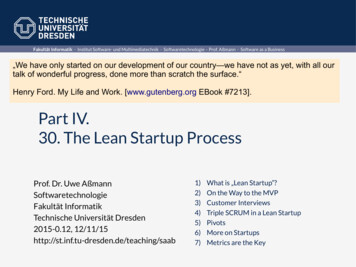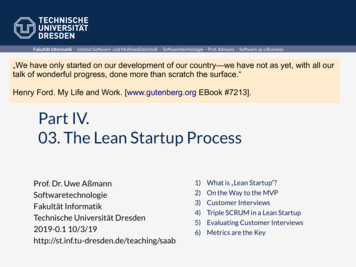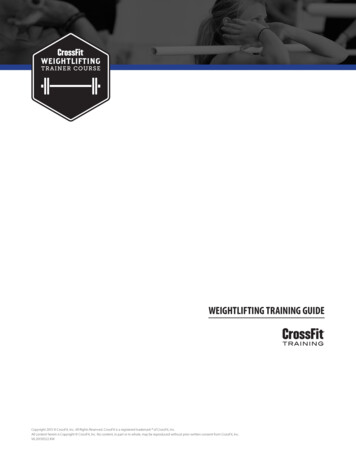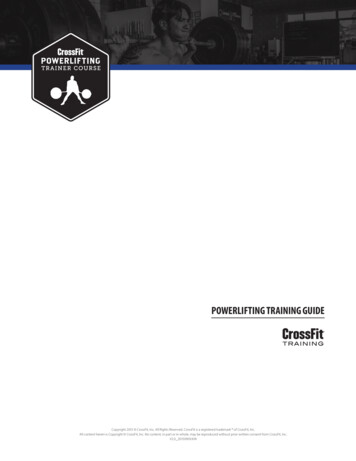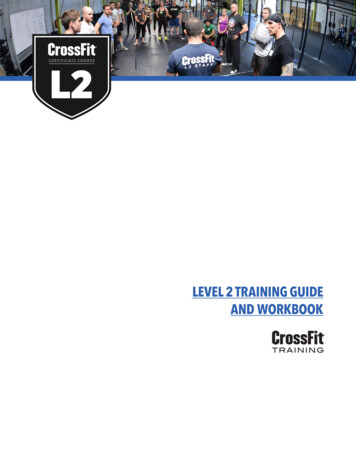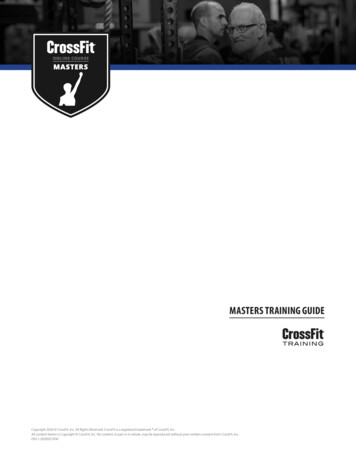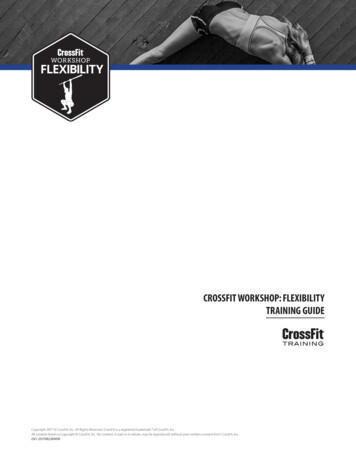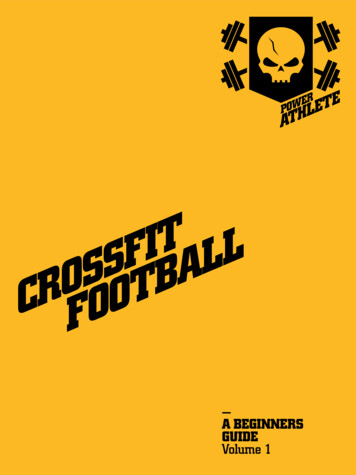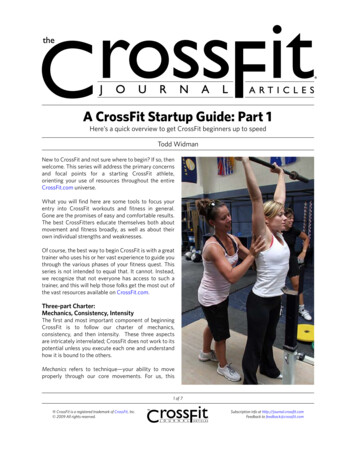
Transcription
A CrossFit Startup Guide: Part 1Here’s a quick overview to get CrossFit beginners up to speedTodd WidmanNew to CrossFit and not sure where to begin? If so, thenwelcome. This series will address the primary concernsand focal points for a starting CrossFit athlete,orienting your use of resources throughout the entireCrossFit.com universe.What you will find here are some tools to focus yourentry into CrossFit workouts and fitness in general.Gone are the promises of easy and comfortable results.The best CrossFitters educate themselves both aboutmovement and fitness broadly, as well as about theirown individual strengths and weaknesses.Of course, the best way to begin CrossFit is with a greattrainer who uses his or her vast experience to guide youthrough the various phases of your fitness quest. Thisseries is not intended to equal that. It cannot. Instead,we recognize that not everyone has access to such atrainer, and this will help those folks get the most out ofthe vast resources available on CrossFit.com.Three-part Charter:Mechanics, Consistency, IntensityThe first and most important component of beginningCrossFit is to follow our charter of mechanics,consistency, and then intensity. These three aspectsare intricately interrelated; CrossFit does not work to itspotential unless you execute each one and understandhow it is bound to the others.Mechanics refers to technique—your ability to moveproperly through our core movements. For us, this1 of 7‰ CrossFit is a registered trademark of CrossFit, Inc. 2009 All rights reserved.Subscription info at http://journal.crossfit.comFeedback to feedback@crossfit.com
A CrossFit Startup Guide(continued)means moving yourself and external objects in the mostefficient, effective, and safe manner possible.Consistency has a two-part application: 1) That youare consistent in performing the mechanics of themovement; and 2) That you are consistent in CrossFitworkouts. Both are necessary! CrossFit workouts arevery potent medicine; too much too soon and you canseverely hurt yourself. Luckily, the body adapts quickly,and before you know it, you will be hitting each workoutwith maximum personal intensity.is to improve your fitness for life; no one ever got inshape overnight. If you gradually exceed what you havedone before, soon enough you will be doing the mainsite workouts “as prescribed.”All three together: Now that you understand mechanics,consistency, and intensity, here’s how they all fit togetherunder CrossFit: While many assume that safety is themain concern with proper mechanics —it is certainly thesafest way to train—we can’t emphasize enough thatsound technique is the most efficient and effective roadto fitness. Proper movements will allow you to lift moreweight, perform more repetitions faster, or both. Morework in less time means higher average power (force xdistance / time power). Higher average power meanshigher intensity. Higher intensity means better results.Therefore, proper mechanics are the ideal supports forthe bridge to fitness.A Brief Explanation of FitnessFitness, most broadly defined, is the ability to handlethe demands of your life. Each of us has both differentand unpredictable demands. A firefighter has no ideahow big the fire will be on his next call, just as Grandmahas no idea how heavy each grocery bag will be the nexttime she goes to the store. Very different concerns, forcertain, but the ability to handle each requires the samebasic abilities. As Coach Glassman has said for years,“The needs of our grandparents and soldiers differin degree, not kind.” These needs are the functionalcompetencies to move our own bodies and externalobjects through three-dimensional space.Intensity, as Coach Greg Glassman, founder and CEOof CrossFit, formally states, is the independent variablemost commonly associated with the rate of return onfavorable adaptation. More simply put, intensity bringsabout all the good results from working out. However,we also have to realize that intensity is relative to ourphysical and psychological tolerances. This is a process,and one that takes an indeterminate amount of time, sobe patient. Elite-level athletes may be ready to ramp uptheir intensity in a couple of weeks, while de-conditionedathletes can take months or longer. The goal of CrossFit2 of 7‰ CrossFit is a registered trademark of CrossFit, Inc. 2009 All rights reserved.Subscription info at http://journal.crossfit.comFeedback to feedback@crossfit.com
A CrossFit Startup Guide(continued)The CrossFit exercises that we use the most are whatwe have found to be the most effective ways to builda broad, general, and inclusive functional competence.Squatting, picking things up off the ground, puttingthings overhead, pulling ourselves up, running, jumping,throwing; these are the movements of life, and donewith intensity, they prepare us for the demands of life.exactly the same number of reps at the same loads in lesstime, your intensity went up. If you increased the loadsand kept the same time (or finished even quicker), yourintensity went up. These direct comparisons give you aquantifiable gauge to the increase of your fitness. You aremeasuring the changes in your capacity and scientificallyproving that you are getting fitter and more capable.CrossFit has a concise yet comprehensive definition offitness that is a bit of a mouthful: Fitness is increasedwork capacity across broad time, modal, and age domains.What this means is that you have functional capacity inall different types of movements at a variety of durationsof effort, throughout your life. If you are increasing thisbroad work capacity, you will be competent at bothshort bursts of activity and extended, longer workouts.The great majority of functional movements are complexand difficult to master. But the advantages of developingproficiency in them far outweigh the inconvenience andeffort required to learn them. There are physical andneurological benefits uniquely associated with thesemovement patterns, benefits that translate broadly intothe various movements and skills of life.Many people wonder why CrossFit workouts are timed.There are several reasons for this, the most importantbeing intensity. Remember that average power is workdivided by time. The same work done in less time ismore power and more intensity. Your first workoutsshould be done at a relatively low intensity. This isessential for you to both learn the proper mechanics ofthe movements and to let your body acclimate to theworkload. Every time you repeat a workout, you cancompare your performance and see if you are increasingyour power (therefore intensity). For example, if you do3 of 7‰ CrossFit is a registered trademark of CrossFit, Inc. 2009 All rights reserved.Subscription info at http://journal.crossfit.comFeedback to feedback@crossfit.com
A CrossFit Startup Guide(continued)For a more in-depth discussion on technique and itsaffect on fitness, read Greg Glassman’s revolutionaryfeature CrossFit Journal article, What Is s-fitnessby-greg-glassm.tplStart with the Squat“There is no better place to start an examination offunctional exercise than by learning how to squat.”-Greg GlassmanEarly Seminars – The Squat 4-15-05 by Greg Glassman,Oct 24, 2008, for another excellent description onthe basic fundamentals of the Squat in video formatfrom an early CrossFit Seminar. ---the-squat-4-15-05.tplAnd Air Squats, the main page video example of ourelemental movement. Video - [wmv][mov]Before we begin a discussion of the squat, checkout these foundational explanations of our mostessential movement.Squat Clinic by Greg Glassman, Dec 01, 2002, for aquintessential article on why and how to perform thesquat, with performance standards, potential faultsand fixes for the movement. y-greg-glassman.tplHow is your squat? Does it look like the models inthe article and videos above? If not, there is no betterprescription for your fitness than moving toward aperfect squat. If your squat is pretty good (going to fulldepth!) and you have been working out for a while, thentry testing yourself with Tabata Squats.The Tabata interval, adapted from Dr. Izumi Tabata, isa regularly used CrossFit training device of 20 seconds4 of 7‰ CrossFit is a registered trademark of CrossFit, Inc. 2009 All rights reserved.Subscription info at http://journal.crossfit.comFeedback to feedback@crossfit.com
A CrossFit Startup Guide(continued)of work followed by 10 seconds of rest, and repeat eighttimes. For Tabata Squats, perform as many full range ofmotion air squats as you can in 20 seconds, then restfor 10 seconds, repeated eight times consecutively. Yourscore is the single lowest number of repetitions in any ofthe eight rounds. As an approximate benchmark, if yourscore is 12 or above, then you have achieved a workingproficiency in the squat and can move on comfortably.If your lowest score is 11 or below, continue to try andattain a level of proficiency and capacity in the squat,the foundation of core movements. You do not needas much variety nor do you have a need for the morecomplex movement patterns yet. Progress in the squatis the primary need for your beginning fitness, and it willcarry over into all realms of fitness.For remediation and further information regarding thesquat check out the following CrossFit resources:1) Coming Forward Onto Toes. In this short clip, NicoleCarroll points out this very common fault in people’ssquat technique. Note what she is looking at on Annyand her cues to fix the movement. [wmv][mov]2) Why Heels? This a great clip of Coach Glassmanexplaining why we must be so focused on keeping theheels on the ground during the squat. [wmv][mov]3) Squat Therapy. Nicole and Coach take Laura throughan excellent remediation exercise, referred to as SquatTherapy, used to improve the capacities within theSquat. [wmv]4) Going Deep by Mark Rippetoe, CFJ Issue 49, Sep2006; This is a detailed, anatomy-based discussionof the ‘how to’ and ‘why’ of going to the crease of thehip below the knee in a squat. mark-rippetoe-se.tpl5) You Don’t Know Squat Without An “Active Hip” byMark Rippetoe, Nov 26, 2008; This is a very wellwritten article on why you need to push your knees outat the bottom of the squat, as well as turn the pelvisover hard throughout the full range of motion, activelyengaging the lower lumbar spine. squat-without-anactive-hip.tpl6) CrossFit Kids – Teaching The Squat by Jeff Martin,Oct 6, 2006; This is an excellent short video of JeffMartin talking through some different cues to helpportray movement mechanics to kids as well as t-kids--teaching-the-squat.tplThe Next Step: Base Proficiency BenchmarksFor those with a score of 12 or more for Tabata Squats,and who possess acceptable to excellent mechanics,I have come up with a list of “base proficiency”benchmarks. The purpose of these benchmarks isto give you a sense of the skills you need before youshould embark on scaling regular CrossFit workouts.In other words, regular, scaled CrossFit workoutsassume that you have achieved a certain base capacityin a variety of movements. The movements below arealso a general gauge of whether or not you have thosebase proficiencies. The list is not perfect, but if youfind that you cannot perform any of the below listedskills, working on those particular deficiencies is moreimportant than doing regular CrossFit workouts.5 of 7‰ CrossFit is a registered trademark of CrossFit, Inc. 2009 All rights reserved.Subscription info at http://journal.crossfit.comFeedback to feedback@crossfit.com
A CrossFit Startup Guide(continued)workouts if you want. You can find further informationand tips on scaling main site workouts within thefollowing CrossFit resources. We will also be coveringtechniques and approaches to scaling in future articles.- 10 overhead squat with PVC- 10 push presses with a barbell equal to 1/3 of yourbodyweight- 5 deadlifts at 1/2 bodyweight- 5 push-ups from knees with hands on ground (men) or ona bench (women)1) Scaled Workout Demo. This is a perfect video exampleof how everybody does the same workout (preservesthe same stimulus) but there are infinite ways to scalethe workout, designing each specifically for the athlete’scapabilities and limitations. [wmv][mov]- 5 jumping pull-ups- 10 wallballs to a target two feet above your reach with an8-lb. ball (men) or a 4-lb. ball (women)- 10 Abmat sit-ups with feet anchored2) A Beginners Guide To CrossFit by Greg Glassman, Oct01, 2004. This is an excellent article written by Coachpointing out the relevance of CrossFit for all athletes,regardless of age or fitness level; the key being scalingand preserving the stimulus of functional innersguide-to-crossfit.tpl3) Assistance for Bodyweight Exercises by Greg Glassman,Aug 01, 2004. This article is an easy to follow breakdownof how to scale for gymnastic exercises, replete withnumerous pictures to demonstrate the sistance-forbodyweight-exer.tpl4) Seniors and Kids by Greg Glassman, Feb 01, 2003.Another great article briefly explaining the basics ofscaling for all levels of fitness. ds-feb-03-cfj-1.tpl5) CrossFit SV Beginners’ Ladder by Judd Xavier and TomRankin, Oct 21, 2008. A fantastic scaling and benchmarktool written up by the owners of CrossFit Silicon Valleyto aid beginners in attaining the goal of using the WOD’soff the main site. ginners-ladder.tpl6) Training For The Aged by Mark Rippetoe, June 01,2003. An excellent, no-holds-barred discussion ofthe importance of working out and lifting weightsfor all, especial
entry into CrossFit workouts and fitness in general. Gone are the promises of easy and comfortable results. The best CrossFitters educate themselves both about movement and fitness broadly, as well as about their own individual strengths and weaknesses. Of course, the best way to begin CrossFit is with a great trainer who uses his or her vast experience to guide you through the various phases .
